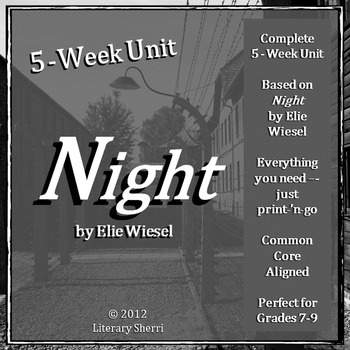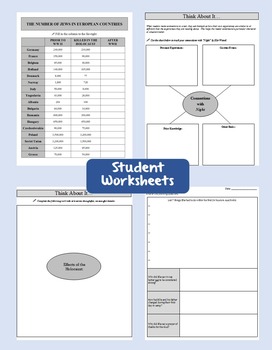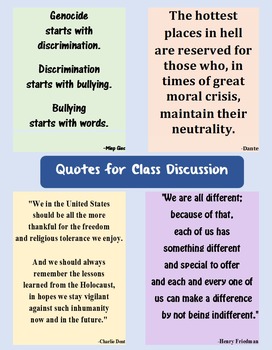NIGHT: Unit Plan, Novel Guide, Lessons, Activities, Assessments - Digital
- PDF
- Easel Activity
Description
This Night unit is structured for close reading, critical thinking, and careful analysis of Elie Wiesel's autobiography. It is structured for easy integration with read-alouds, shared reading, independent reading, guided reading, interactive writing, shared writing, and independent writing, making this rigorous unit ideal for whole-class instruction, inclusive classrooms, reading academic intervention services, or tutoring.
Optimized for digital use via TpT's digital overlay tool. (All answer boxes have been done for you.)
Differentiation is built into this Night unit with guided notes, a study guide for the exam, vocabulary pages set up in 2-column note format (Cornell Notes), photographs to help students better understand the story, and student choice on the questions in the student packet (i.e.: answer 3 of the following 5 questions).
Students are required to extrapolate relevant and appropriate inferences from the story throughout the novel and on the unit test, inspiring them to think deeply and activate higher-order thinking.
THIS 115-PAGE NIGHT UNIT INCLUDES:
- A 25-day calendar outlining plans, essential questions, discussion questions, and activities
- 7 pages of guided notes to build background knowledge prior to starting the novel (which may be presented in Social Studies, if you so choose)
- Key to guided notes (in enlarged font for quick use with Elmo or SmartBoard)
- A 33-page Student Packet with answer keys
- “Hurtful Words” Survey based on a quote by Miep Gies (this allows teachers to facilitate discussions about bullying, discrimination, prejudiced stereotypes, acceptance, and inclusion)
- Graphic Organizers to promote critical thinking
- 2 pages of book recommendations for students who appreciate books about the Holocaust
- 14 photographs of places and/or situations mentioned in the book (enlarged for quick use with Elmo or SmartBoard)
- 6 vocabulary quizzes with answer keys
- A 2-page exam study guide for students who receive support services (or for all students, if you’d like)
- A 4-page unit exam with key
- Learning Objectives, Teaching Tips, and Common Core Standards
This unit culminates with the free activity: Who Was Responsible for the Holocaust.
SHARING IS CARING!
I love seeing my resources in action in your classrooms! If you take a photo of one of my resources in your classroom, I'd like to feature it on social media. Please either tag me on Instagram @literarysherri or email your photo to literarysherri@literarysherri.org. Thank you so much!
LET'S CONNECT!
I ♥ FOLLOWERS!
Click here to follow me and be the first to know about store discounts, free resources, and product launches!
THANK YOU FOR YOUR FEEDBACK!
If you find this resource useful for your students, please leave feedback for other teachers. If the resource can be revised to better meet your students' needs, please reach out to me via my email or Q&A tab.
HAPPY TEACHING -- I'M CHEERING YOU ON!
Questions? Please email: literarysherri@literarysherri.org
© Literary Sherri www.literarysherri.com






